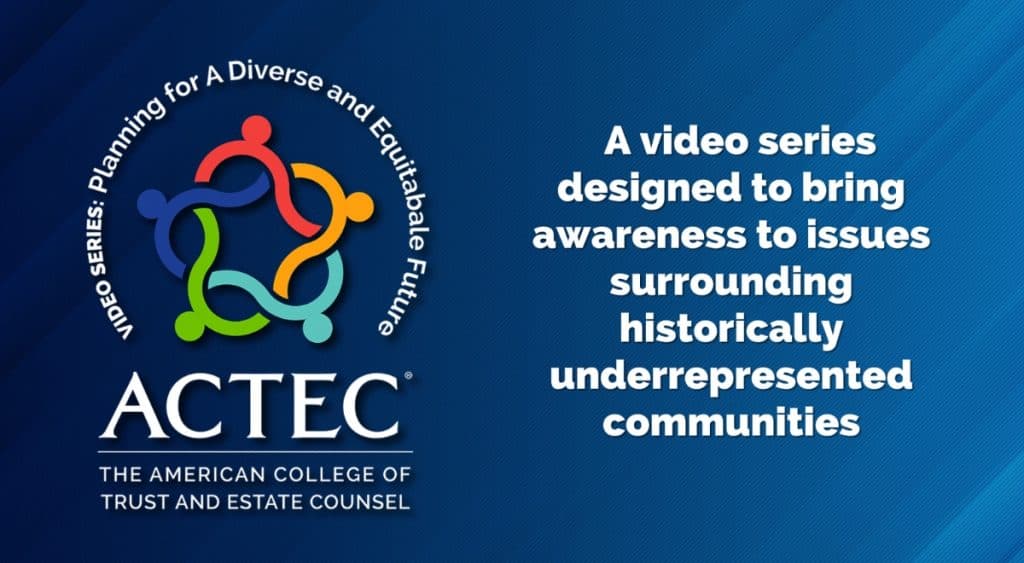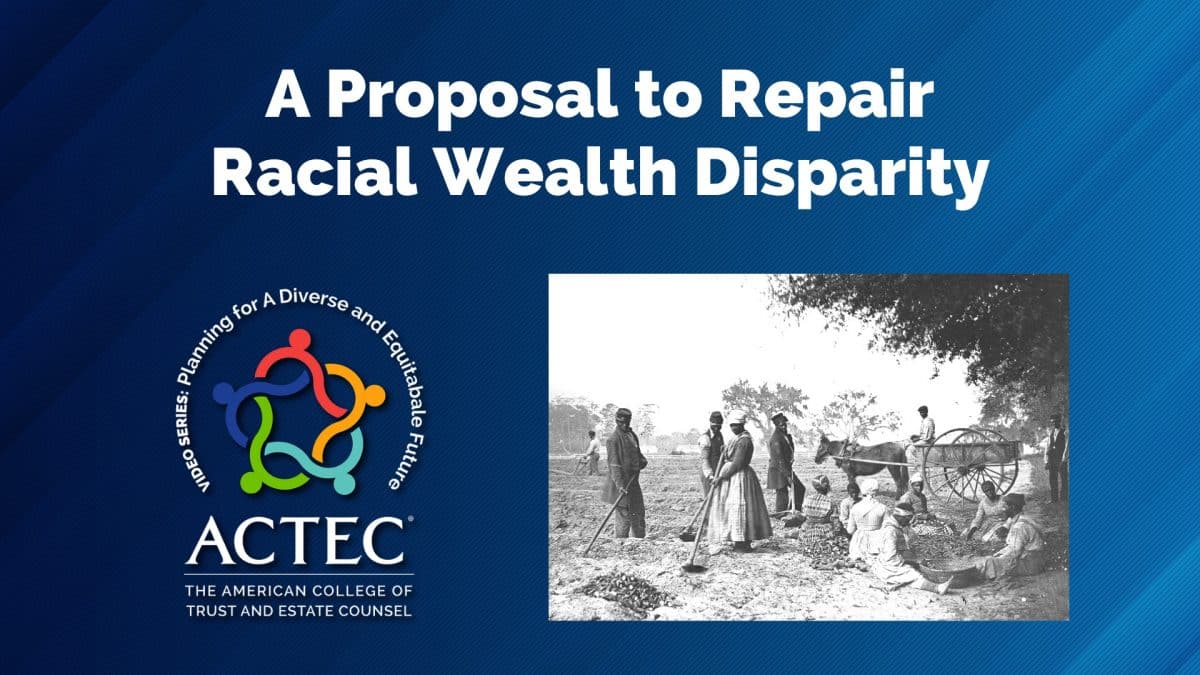Donating to worthy causes to promote the welfare of others is an act of love. As wealth management and estate planning professionals, we help make our clients’ philanthropic decisions become a reality for nonprofits and organizations that amplify their values and causes.
Do we have a role to play in advising clients about organizations that address inequalities of wealth and status? How do we diversify our workforce and have a better understanding of inequality and diversity issues?
Carl Wayne J.D., Senior Advisor of Charitable Estate Planning at the American Heart Association, discusses this topic with Lorraine del Prado, Principal of del Prado Philanthropy and Vice President at Thompson & Associates, and Nicolla Ross, Vice President of Health Strategies for the Western Region of the American Heart Association.

Resources
ACTEC Family Estate Planning Guide — This video library offers clients insight into the fundamentals of wills and trusts to encourage planning.
ACTEC Trust and Estate Talk — A free weekly podcast series that offers wealth planning professionals best practice advice, insights, and commentary on subjects that affect the profession and clients.
- Economic Inequality in America – Renowned author and journalist Rochelle Riley discusses how wealth disparity relates to the estates and trusts practice and how to effectuate change to diminish the racial wealth gap.
- What We Get Wrong About Closing the Racial Wealth Gap – By William Darity Jr., Darrick Hamilton, Mark Paul, Alan Aja, Anne Price, Antonio Moore, and Caterina Chiopris from the Samuel DuBois Cook Center on Social Equity at Duke University
- Systematic Inequality: How America’s Structural Racism Helped Create the Black-White Wealth Gap – By Angela Hanks, Danyelle Solomon, Christian E. Weller from the Center for American Progress
- Estate Planning through a Social and Racial Justice Framework
- Lawyers of Color – Lawyers of Color is a nonprofit devoted to promoting diversity in the legal profession and advancing democracy and equality in marginalized communities.
- Association of African American Financial Advisors – AAAA is a non-profit membership organization for African American financial advisors and affiliated professionals.
- Structural racism is a driver of health disparities, report declares — Article from the American Heart Association published November 10, 2020
- Call to Action: Structural Racism as a Fundamental Driver of Health Disparities: A Presidential Advisory from the American Heart Association — published November 10, 2020 in Circulation, Volume 142, No. 24
- Association of Black Estate Planning Professionals (ABEPP) —ABEPP is a nonprofit organization committed to educating and empowering financial professionals and the community to strategically collaborate and economically transform the black community.
Transcript
Introduction
ACTEC Fellow Terrence M. Franklin: As wealth management and estate planning professionals, it is sometimes difficult to know what actions we can take to address issues of inequality. This episode discusses how professionals can use an equity and diversity lens when working with clients; the philanthropic attributes clients might look for in nonprofits, and how one national organization, the American Heart Association, has adapted its work to address health disparities and other inequitable outcomes in communities of color.
Carl Wayne, Senior Advisor of Charitable Estate Planning at the American Heart Association, is joined by Lorraine del Prado, Principal of del Prado Philanthropy and Vice President at Thompson & Associates, and Nicolla Ross Vice President of Health Strategies for the Western Region of the American Heart Association.
Carl Wayne: Let’s start this discussion with Lorraine sharing her perspectives on estate planning. What can attorneys and other professional advisors do to be part of this movement of greater equity?
Steps Attorneys and Professional Advisors Can Take To Encourage Equality
Lorraine del Prado: Thanks, Carl. Like anything else, attorneys and other advisors gain greater credibility if you start with your own personal racial justice work first. You can do this on your own or through your firm or organization’s diversity, equity and inclusion initiatives. This is ongoing work that may take years of reading, listening, reflections, difficult conversations, civic engagement and self-awareness.
- The purpose of this personal racial justice work is to first deepen your understanding and exploration of racism and white privilege and how these have been manifested in your life, behavior and work. I found it very useful, as part of this exercise, to explore the sources of one’s opportunities and wealth and how these may be attributable, in part, to the unearned privileges of being white–whether it’s the neighborhood you came from, the school you were able to attend, or the professional connections that landed you that internship, that interview or that great job.
- This personal racial justice work also aims to find meaningful and authentic connections with Black, Indigenous and other marginalized people of color, and to find ways to be proximate to their experience, their pain and their suffering. Bryan Stevenson, author of “Just Mercy” said, “We cannot create justice without getting close to places where injustices prevail. We have to get proximate.”
- And finally, this personal work entails that you commit yourself to be an ally. To help address inequity and racial injustice; whether it’s through your actions, work, philanthropy, volunteering, your hiring practices, your investments, voting and advocacy.
Carl Wayne: It will take time for anyone to do the personal racial justice work. It may take them a lifetime to do this work real justice (no pun intended). In the meantime, are there ways that attorneys can demonstrate their alignment with and commitment to equity?
Steps Attorneys and Professional Advisors Can Take To Encourage Equality
Lorraine del Prado: Definitely. We should never let perfection be the enemy of doing good, right? Here are some ways that advisors can contribute to a more just and equitable world through their profession:
- You can volunteer for pro-bono estate planning clinics that help low-income communities of color get their wills and powers of attorney in place or financial planning clinics that help them get their finances in order. This would be very much like the Free Wills for First Responders initiatives that have occurred in various states. According to the Caring.com 2017 survey, almost 70 percent of African Americans do not have wills. This prevents them from transferring their assets in a thoughtful and strategic way to their families. Tragically historic distrust of government has kept many from doing estate plans, resulting in unclear titles of lands that made their descendants’ ownership of these properties even more tenuous.
- You can mentor, champion and sponsor law students and students of finance and young lawyers and wealth advisors of color. Help them build connections to professional networks that would be very helpful for their future opportunities and career support. Inspire them to enter the estate planning profession, so that communities of color can be more motivated to get their plans in place, using professionals who look like them and can understand their experiences and challenges.
- You should endeavor to hire professionals of color for your own firms. If you don’t have enough candidates because your town is not that diverse, do a national search. You can explore resources like Lawyers of Color.org. The Association of African American Financial Advisors, which has profiles of these advisors of color, publishes an annual Nation’s Best and Hot List, which has profiles of attorneys of color.
- Very importantly, you should engage in courageous conversations with your clients, really exercising your role as counsels, and presenting estate planning as not merely the transfer of assets from one generation to the next in the most tax-efficient way, but a very intentional way of deploying assets to create good in the lives of your clients’ heirs and in society. In these courageous conversations, you may wish to inquire about your clients’ reactions to the national reckoning with racial inequities in American society. If your clients express an interest in pursuing racial justice, then ask their permission for you to explore with them the various ways that they may incorporate racial justice values in their estate plans, especially in the context of the racial wealth gap. Based on a 2016 study of the Pew Research Center, the average net worth of a white person is $171,000, which is ten times larger than the average net worth of an African American, which is $17,000. If you think about it, estate planning enables the transfer of assets “inequitably” owned from one generation to the next. Estate planning is, therefore, an unintentional facilitator and perpetuator of the wealth divide among whites and marginalized people of color. How should we then approach estate planning after recognizing that fact? Does your client’s estate plan help launch their heirs into productive, resilient and purposeful lives, or does it create entitled, privileged and directionless trust fund babies? Does your client’s estate plan contribute to building a just and equitable world for succeeding generations? Is leaving a world where huge segments of society do not have access to resources, power and opportunity acceptable to your clients, to their children and to their grandchildren?
Carl Wayne: Suppose clients are open to exploring how they can incorporate racial justice in their estate plans. What might attorneys suggest as ways of doing that?
Incorporating Support of Racial Justice in Estate Plans and Wealth Management
Lorraine del Prado: There are various ways that clients can incorporate a racial justice lens in their estate plans and wealth management. Here are three primary ways:
- Clients can make purposeful gifts or bequests to nonprofit organizations that are dedicated to decreasing disparities and increasing equity.
- Clients can demand that their trust assets be invested in companies that embrace diversity, equity and inclusion and that don’t capitalize on harm to communities of color – whether these are payday loans, private prisons, gun manufacturing or pipelines on indigenous land.
- Finally, clients should also expect greater diversity in the firms they engage for estate planning and wealth management. Do these teams include people of color in their leadership? Do they have programs around promoting diversity, equity and inclusion in their workplace? Are they grooming, training or mentoring people of color to advance to positions of greater responsibility in their teams?
Carl Wayne: Those are great suggestions, Lorraine. Let’s zoom in on the charitable bequests of clients. What attributes of organizations should clients look for if they are wanting to advance equity and reduce disparities?
Supporting Justice-Focused Organizations
Lorraine del Prado: Washington Women’s Foundation and Resource Generation have proposed some wonderful criteria that I share with clients interested in supporting justice-focused organizations. I encourage them to look for:
- Organizations that are focused on providing services and building systemic change for communities experiencing disparities and inequities due to their race.
- These organizations should be accountable to the communities of color being served so they are led and guided by people from these communities and they are lifting up voices and grooming future leaders from communities of color.
- These organizations should strive to address the root causes of inequities and have on-the-ground experience on these issues.
- And finally, these organizations should be able to demonstrate progress in their endeavors of reducing disparities and increasing equity.
I also ask my clients to give special attention to Black-led organizations. These organizations are on the frontlines of creating social change and yet they have historically received less than 2 percent of foundation grants. Their systemic exclusion from traditional sources of social, economic and political support greatly puts them at a disadvantage for fundraising, and that is partly responsible for their modest budgets. The size of their bank account, however, does not necessarily speak to their effectiveness.
Carl Wayne: Thank you, Lorraine. Very interesting perspectives you’ve shared with us. In the next part of this conversation, we will look at an example of how my organization, the American Heart Association, is focused on improving health equity in communities of color. We will discuss it within the context of our 2024 Impact Goal. Nicolla what is our 2024 Impact Goal?
American Heart Association’s Focus on Equity
Nicolla Ross: Our 2024 Impact Goal states that every person deserves the opportunity for a full and healthy life. As champions for health equity, by 2024, the American Heart Association will advance cardiovascular health for all, including identifying and removing barriers to health care access and quality. Everyone deserves an optimal and just opportunity to be healthy, giving special attention to the needs of those at greatest risk of poor health, and so that no one is disadvantaged from achieving their potential because of social position or any other socially defined circumstance.
Carl Wayne: Nicolla, what are two major drivers of health disparities, and describe how the American Heart Association is addressing them to achieve equitable health for all?
Nicolla Ross: Two major drivers of health disparities are:
- The social determinants of health, and
- Structural racism
We believe that addressing both of them is the way to truly achieve equitable health and well-being for all. So, let’s look at where health, equity and science come together. From our beginning in 1924 until today, health equity has always been a major part of our work.
We have progressed through the decades and gains were made, but unfortunately, not for everyone. People of color and communities without resources were disproportionately impacted by heart disease and stroke. And we had to figure out why. Although science pointed us in the right direction, in 2015, we began to focus on the social determinants of health. Those are the conditions in which people are born and live, such as having access to healthy food, affordable housing, good jobs, clean air, and education.
But even the combination of all of this work wasn’t enough to address the challenges facing all populations in this country. So, in 2020, science again led us to an additional area of focus: Structural racism as a driver of health disparities. Structural racism is a system in which public policies, institutional practices, cultural representations, and other norms work in various reinforcing ways to perpetuate racial group inequity. To reach our goal of giving everyone the opportunity for a full, healthy life, we must remove barriers to health, including structural racism.
Carl Wayne: To further expand on its commitment to bring about change in this area, in November 2020, the American Heart Association published an important presidential advisory about the health impact of structural racism. Nicolla, can you tell us more about it?
Nicolla Ross: In the news release announcing the publication of the presidential advisory, Mitchell Elkind, M.D., the president of the American Heart Association National Board of Directors, and professor of neurology and epidemiology at Columbia University, is quoted as saying, “With this advisory, the American Heart Association reiterates its unequivocal support of antiracist principles. We are going beyond words to take immediate and ongoing action to accelerate social equity. Every person must have the same opportunity for a full, healthy life. The American Heart Association will work with allies to remove barriers and provide an equal playing field, because literally, lives are at stake. The people historically marginalized in communities deserve nothing less — and our society must demand it.”
Carl Wayne: Nicolla, how can people find out more about our work on this topic?
Nicolla Ross: You’ll find more information about this topic in the Resources tab of this presentation. In particular is the call to action: Structural Racism as a Fundamental Driver of Health Disparities: A Presidential Advisory From the American Heart Association, published in the Association’s flagship scientific journal “Circulation.” The advisory reviews the historical context, current state, and potential solutions to address structural racism in the U.S.; and it outlines steps the Association is taking to address and mitigate the root causes of healthcare disparities.
Carl Wayne: Thank you, Lorraine and Nicolla for sharing your insights and expertise on this important topic. Thank you to our audience for listening to this conversation. We hope it deepened your understanding of the many ways that we can all contribute toward a more Diverse and Equitable Future.
ACTEC Fellow Terrence M. Franklin: Carl, Lorraine and Nicolla gave us a lot to think about. A greater understanding of diversity, inclusion and health disparities offers us, as wealth and estate planning professionals, a broader perspective from which to advise our clients. It is also helpful to hear how the American Heart Association is addressing these issues. What will you do to positively impact your organization and clients?
Please visit ACTEC, actec.org/diversity for resources on this topic, and also subscribe to ACTEC’s YouTube channel to be informed of new videos as they become available.
Featured Video
A Proposal to Repair Racial Wealth Disparity
Experts in tax law present their research on racial wealth disparity as well as recommendations for funding and distributing reparations to Black Americans.
Planning for a Diverse and Equitable Future

ACTEC’s diversity, equity, and inclusivity video series analyzes issues surrounding racism, sexism, and discrimination in all its forms to combat inequality.

